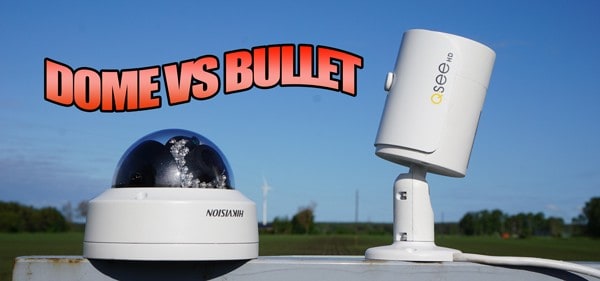Bullet cameras and dome cameras are the most common camera types used for home and business security today. Both are easy to install, manageable and offer complete control to the user when securing areas of any size. Bullet cameras, as the name suggests, protrude outwards like a gun’s barrel, while dome cameras have the rounded “dome” shape, to all but mark the biggest difference between them.
When it comes to functionality, the two camera types possess extreme similarity, but still, the small differences can be of great significance considering the specific purpose you are looking to cover.

Installation
Bullet cameras are much easier to install because they come with a mounting handle which you only need to attach to the wall. Once they are mounted, you can move them to cover whatever area you want. Dome cameras are more complicated to mount but do not require much effort either.
The only snag comes when you have to change the field of view because you will have to dismount the camera and mount it again. An expert would do it better.
Location of Camera
Both bullet and dome cameras can be used for indoor purposes but dome ones are more common and more suitable because of their low intrusiveness. If you are looking for something more sleek and elegant; something that will match the décor of the building or household without much adjustments, a dome camera would be a wiser choice.
On the other hand, bullet cameras are usually weatherproof and have a longer range, making them more suitable for viewing large areas such as extensive backyards and parking lots. NOTE: To discover a camera’s environmental protection, check its IP Ratings.
Range
The range that a surveillance camera can cover depends on vital features such as type of sensor chip, type of lens, Wide Range Dynamic, lines of resolution, Back Light Compensation, and Auto Gain Control. Though it’s hard to generalize it, dome cameras have smaller lenses compared to bullet ones – whose shapes can accommodate larger lenses – making them less suitable for long-distance purposes.
You could however find some dome cameras whose lens sizes are equal, or even bigger than those of bullet ones. Choosing the right one, in this case, is mainly a matter of preference.
Light Level
Both bullet and dome cameras have infrared LEDs to ensure the availability of light is not much of a factor. With an infrared LED, a camera is guaranteed proper lighting to function. During the day or when there is sufficient lighting, the common lenses are used, but once the camera senses poor lighting in the field of view, it uses infrared LEDs to create its own light.
Open or Covert?
Bullet cameras which are more visible and obvious to passers-by are more suitable if you are looking to discourage vandalism or theft. Dome cameras are a little bit harder to spot, and that makes them a better choice if you are looking for something more covert.
They do not stick out like bullets and the dome housing hides what you are capturing since it’s hard to tell where the lenses are pointing. Another clear-cut advantage of dome over bullet cameras is that dome cameras can rotate 360 degrees covering a larger circumference.
Cosmetics
As stated earlier, dome cameras fit better with your current décor. This is because the dome shape makes them less intrusive and more elegant than bullets. The shape also makes them look more seamless and cleaner, particularly due to their ability to hide wiring, unlike bullet cameras, whose wires will always be slightly exposed at the back.
Again, it is hard to generalize on this, because some domes will have exposed wires while some bullets will not.
Durability
Dome cameras, especially ones known as “vandal proof”, win the durability test by a landslide. “Vandal proof” domes are enclosed in durable housings that can stand anything right from shaking to vandalism. They are particularly apt if mounted on easily accessible places such as low ceilings.
Conclusion
There is huge misapprehension when understanding the differences between bullet cameras and dome cameras is subject. There are notions surrounding surveillance cameras that could influence your choice, but only guided scrutiny of the above features, together with sufficient knowledge of the purpose to be served by the camera, would help you make the perfect choice and buy a product that will give you value for your money. For more info check out our Buyer’s Guide!
